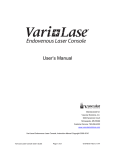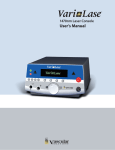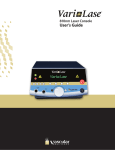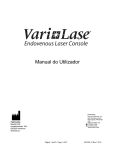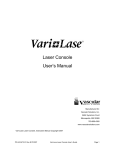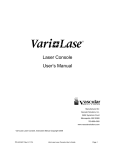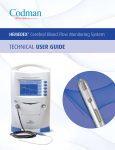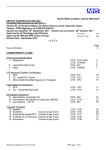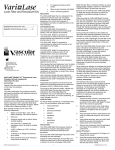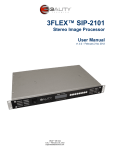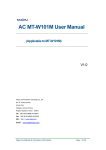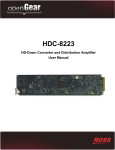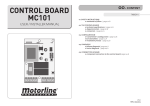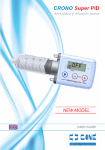Download Technical Specifications for the Vari-Lase laser
Transcript
810nm Laser Console User’s Guide User’s Manual Manufactured by: MedArt A/S Industriholmen 15A DK2650 Hvidovre Denmark Page 1 of 35 42-0706-05 Rev D 1/13 Vari-Lase Laser Console, Instructions For Use Copyright 2009 - 2012 MedArt A/S, Industriholmen 15A, DK-2650 Hvidovre, Denmark. Photographic, mechanical or other reproduction of this manual or any part thereof is not permitted without written permission from MedArt A/S. Date: July 6, 2010 MedArt A/S Industriholmen 15A DK2650 Hvidovre Denmark Phone: Fax: Mail: Web: Page 2 of 35 +45 3634 2300 +45 3634 2323 [email protected] www.medart.dk 42-0706-05 Rev D 1/13 Table of Contents Table of Contents ............................................................................................................................................... 3 Caution ................................................................................................................................................................ 4 Handling Precautions ........................................................................................................................................ 5 Introduction ........................................................................................................................................................ 5 Intended Use ....................................................................................................................................................... 6 Endovenous Procedure Kit ............................................................................................................................... 7 Installation and User Obligations ..................................................................................................................... 7 Safety ................................................................................................................................................................... 7 Labels and Symbols......................................................................................................................................... 10 Description of Operating Console .................................................................................................................. 12 Operation .......................................................................................................................................................... 14 Output Power Verification ............................................................................................................................... 16 Definition and Retrieval of Treatment Parameter Sets ................................................................................. 17 Remote Interlocking ......................................................................................................................................... 18 Bare Fiber Connection ..................................................................................................................................... 19 Connection and Release of Foot Switch........................................................................................................ 19 System Setup and Status Display Controls .................................................................................................. 20 Service/Adjustment Functions ....................................................................................................................... 21 Cleaning and Maintenance .............................................................................................................................. 24 Main Power Connection and Replacement of Fuses .................................................................................... 24 Trouble Shooting .............................................................................................................................................. 25 Warnings and Stop Codes............................................................................................................................... 26 NOHD (Nominal Optical Hazard Distance) and MPE .................................................................................... 27 Protective Eye Wear ......................................................................................................................................... 27 Service and disposal........................................................................................................................................ 27 Storing and Transportation ............................................................................................................................. 28 Technical Specifications for the Vari-Lase laser console............................................................................ 29 Guidance and manufacturer’s declaration – EMC topics ............................................................................ 31 Appendix A ....................................................................................................................................................... 34 Page 3 of 35 42-0706-05 Rev D 1/13 Caution 1. The Vari-Lase laser console is a Class 4 laser, which emits invisible laser radiation. 2. Avoid exposure to direct or scattered radiation. 3. Patient, operator and others in contact with the laser must wear suitable protective eyewear. Protective eyewear must be of a quality corresponding to the standards IEC 60825 and EN 207. 4. The fiber systems for the Vari-Lase laser console must be used only with a suitable handpiece or as a delivery system in connection with endovenous treatments. 5. Read the operating instructions thoroughly before connecting the laser unit to main power and prior to use. The laser unit must be set, regulated and used in accordance with the instructions for use. Failure to observe usual safety precautions may present a risk of hazardous exposure to laser radiation. 6. When the laser unit is not in use, ensure that it is rendered inaccessible to unauthorized personnel. Remove the key to disable the laser unit. These warning labels are placed on the laser unit Restrictions on use of Class 4 laser equipment The Vari-Lase laser system is intended solely for physicians trained in the use of these instruments. The safety precautions for Class 4 laser equipment must be followed. The physician is responsible for evaluating each patient’s suitability to undergo laser surgery and furthermore to inform the patient about any risks involved, the actual treatment, pre- and postoperative care and any other relevant information. All use of the equipment is based on the doctors’ knowledge and experience. The doctor is responsible for correct diagnosis and for all treatment results. MedArt undertakes no liability whatsoever for any damage or injury as a result of an application of a product which is not in strict accordance with intended use and the instructions provided with the product. This waiver also includes liability for any damage and injury arising as a result of the product user’s lack of qualification to evaluate the treatment applied in the actual individual circumstances, or as a result of errors or mistakes committed by such user who would otherwise be considered as having the necessary professional skills to apply such treatment. Page 4 of 35 42-0706-05 Rev D 1/13 Handling Precautions Do not bend the fiber excessively. Avoid bending diameters smaller than 12cm. Avoid touching the fiber ends. Introduction We congratulate you on the purchase of this Vari-Lase laser system, among the most advanced and user-friendly diode lasers available. It constitutes the fruition of many years of experience in the manufacturing and development of high technology medical laser equipment. The Vari-Lase laser console is fed by a diode laser module, which can provide a continuous or pulsed wave laser beam. It has a highly intelligent user interaction system - even though it is a very compact system. Rigorous quality control and factory testing ensure the very highest levels of quality and reliability. The laser unit incorporates various fail-safe systems and conforms to international standards for medical electrical equipment, IEC 60601-1 and those specifically for laser equipment IEC 60601-2-22 and IEC 60825. The Vari-Lase laser console conforms to the EU Medical Device Directive (MDD 93/42/EEC). This product is marked with type number MedArt 700. The type number uniquely identifies the product. The type number is placed on the type label located on the rear panel of the product. The Vari-Lase laser console is marked with MedArt A/S Page 5 of 35 42-0706-05 Rev D 1/13 Intended Use The Vari-Lase laser console is indicated for endovascular medical therapy of vascular conditions. It transmits through an optical fiber and 21 the power density reaches 11.9kW/cm enabling the laser to coagulate, evaporate and carbonize tissue. The Vari-Lase laser console operates with a wavelength of 810nm. The 810nm wavelength is primarily absorbed in melanin, hemoglobin and dark tissue and only a limited amount of the light is absorbed in water. This enables a fast heat increase in the irradiated area, leading to effective heating of tissue at low output power. Indications for the Vari-Lase laser console The Vari-Lase laser console is indicated for the medical treatment of varicose veins and varicosities associated with superficial reflux of the Greater Saphenous Vein. Contra indications for the Vari-Lase laser console The Vari-Lase laser console procedure is contraindicated in patients with an aneurismal section in the vein segment to be treated. The Vari-Lase laser console procedure is contraindicated in patients with severe peripheral vascular disease, as evidenced by an anklebrachial index of < 0.5. The Vari-Lase laser console procedure is contraindicated in patients with thrombus in the vein segment to be treated. The Vari-Lase laser console is contraindicated in patients with a history of deep vein thrombosis. Caution Caution should be used in advancing the sheath in case of extremely tortuous anatomy of the great saphenous vein to minimize damage to the vessel. Caution If not properly performed, endovenous laser treatment may form a major risk to the patient’s health. The endovenous laser treatment shall be carried out solely by properly trained physicians. Caution Caution should be used in patients that have a demonstrated history of peripheral vascular disease to ensure that the nature extent of the disease is known and accounted for in the treatment plan. 1 Max. Power density in a 300µ fiber Page 6 of 35 42-0706-05 Rev D 1/13 Endovenous Procedure Kit To ensure a safe and efficient treatment, use the Vari-Lase endovenous procedure kit. Details on the nearest dealer can be obtained from Vascular Solutions, Inc. (address on page Error! Bookmark not defined.). Installation and User Obligations The Vari-Lase laser console is designed to operate within normal room temperature (15-27°C / 59-81°F) and humidity conditions. The unit must be allowed to acclimatize before use following exposure to extreme temperature or humidity. Do not install the unit close to radiators or other sources of heat convection. The Vari-Lase laser console may overheat due to excessive room temperature in combination with operation at high output power. In case of overheating the laser unit will automatically shut down for a short cooling period. Hereafter the laser unit will be ready for continued treatment. We advise against the use of lasers at a distance of less than 2.5m from short-wave or microwave equipment, since unstable laser irradiation may occur. No attempt should be made by unauthorized persons to open the Vari-Lase laser console with a view to repair. Failure to observe this caution may present a serious safety hazard and will void warranty. MedArt cannot be held liable for events resulting from negligence, abuse or incorrect operation of the unit. Please acquaint yourself thoroughly with the instructions for use, and in the event of doubt contact your Vari-Lase dealer. Safety The Vari-Lase laser console is designed and tested for maximum safety for both the user and patient. It is however, ultimately the operator’s responsibility to introduce safe practices, which ensure the safety of personnel and equipment. WARNING Only MedArt trained personnel should attempt to inspect and/or repair the Vari-Lase laser console. The Vari-Lase laser console contains no user serviceable parts. Electrical safety The system must be grounded. Page 7 of 35 42-0706-05 Rev D 1/13 Optical safety Avoid exposure to laser radiation in excess of the allowable limits listed in Title 21 U.S. Code of Federal Regulation, parts 1040.10 and 1040.11, during the installation and operation of the Vari-Lase laser console. WARNING Injury to the eyes and the epidermis can result from either direct or scattered radiation. The power density of the light emitted from lasers can be high enough to cause severe burns to the skin when directly exposed to the beam. WARNING All personnel in the operating room must be protected from stray and scattered radiation by wearing the appropriate protective eye-wear to guard against ocular injury. Never look directly into any laser beam. Use surgical instruments with a dull and dark anodized finish whenever possible. Shiny surfaces can reflect laser beams. Take extreme care if shiny surgical instruments are used. Fire and explosion precautions Combustible material can ignite if exposed to certain wavelengths of laser radiation. WARNING Do not operate the laser in the presence of explosive gases and liquids as well as highly concentrated oxygen. The following precautions can minimize the risk of fire: a. b. c. Surround the surgical field with wet gaze or towels If possible, eliminate flammable materials from the surgical field Have a fire extinguisher nearby Always place the laser unit in Standby Mode whenever possible. This will prevent accidental firing of the laser. Precautions against transfer of diseases The cleansing and sterilization instructions provided by this manual shall always be followed to avoid transfer of diseases through patient contact with operation components. WARNING Insufficient cleansing or sterilization of operation components that get in contact with the patient may result in transfer of diseases. Page 8 of 35 42-0706-05 Rev D 1/13 Precautions against toxic effects When undertaking endovenous treatments, it is of utmost importance that all materials introduced into the veins of the patient, are fully biocompatible. WARNING Material without properly certified bio-compatibility must never be used for endovenous laser treatment. Precautions against embolic hazard Caution The Vari-Lase Procedure Kit is designed for single use only. Reuse of the fiber may result in hot spots causing combustion and embolisation or fiber fragments. Precautions against hazardous radiation exposure To ensure a safe and efficient treatment, the user must always follow the procedures of this manual. Caution Use of controls or adjustments or performance of procedures other than those specified herein may result in hazardous radiation exposure. Page 9 of 35 42-0706-05 Rev D 1/13 Labels and Symbols The type label is situated at the rear of the laser system. Specifies the name and address of the manufacturer of the equipment. Specifies the rating of the main power supply. Specifies the ratings of the fuses to be used for the equipment. Specifies Type BF Applied Part (Body Floating). European Directive 2002/96/EC requires that equipment bearing this symbol must not be disposed of with unsorted municipal waste. For further details, please see page 27 in this manual. Indicates the foot switch inlet. “DISTRIBUTED BY” Specifies the name and address of the corporation, which distributes the equipment within Europe. Please notice; this corporation is not the same as the manufacturer. Serial number label is situated at the rear panel of the laser. The interlock label is situated under the front panel of the laser system. Page 10 of 35 42-0706-05 Rev D 1/13 A B Service connector A. For service use only. Service connector B. For service use only. Interlocking socket. See paragraph “Remote Interlocking” on page 18. Explanatory label and Laser Warning label is affixed visibly on the fronttop of the system. CDRH and production date label – situated at the rear of the system. Page 11 of 35 42-0706-05 Rev D 1/13 Description of Operating Console Vari-Lase laser console Parameter selection - accompanying LED lit when active Provides the possibility of choosing any pre-programmed set of treatment parameters - accompanying LED lit when active 1-4 Selector keys 5 Program key 6 Menu key Provides access to the various menus features by the Vari-Lase laser console 7 Left key Used for menu browsing and operation 8 Right key Used for menu browsing and operation 9 Back key Used for stepping upwards in the menu hierarchy and leaving the selected menu item without saving changed parameters 10 Enter key Confirms/saves the parameters currently displayed - accompanying LED lit when active Jog wheel Turning the jog wheel clockwise will increase any selected parameter, turning it counter-clockwise will decrease the parameter Ready key When activated the Vari-Lase laser console is set into Ready Mode. See paragraph “Operation” on page 14 for more details 11 12 Page 12 of 35 42-0706-05 Rev D 1/13 13 Standby key When activated, the Vari-Lase laser console is set into Standby Mode. Parameters can be modified, but no laser output can be generated 14 Emergency stop key See paragraph “Operation” on page 14 15 Laser ready indicator Lit whenever the Vari-Lase laser console is emitting aiming light 16 Laser emission indicator Flashing when laser emission occurs 17 Key switch The laser unit is disabled when the key is in off-position or when the key is removed. Text “TURN KEY“ and a key symbol is displayed when the key is turned in off-position 18 Fiber connection Laser pulses are delivered via a fiber assembly 19 Laser beam input port 20 Display 21 Foot switch inlet 22 Laser input port for verification purpose. See paragraph “Output Power Verification” on page 16 Display used for displaying visual information to the user Air foot switch inlet and release button, situated on rear panel Remote interlocking Interlocking socket situated under the front panel. See paragraph “Remote Interlocking” on page 18 23 A Service connector Service connector A. Intended for service use only 24 B Service connector Service connector B. Intended for service use only 25 Main power switch 25 26 Fuse holder 26 27 Main power cable inlet 27 28 Follow Instructions for Use Instructions to follow the information in the Instructions for Use See paragraph “Main Power Connection and Replacement of Fuses” on page 24 Page 13 of 35 42-0706-05 Rev D 1/13 Operation Preparing for use 1. Carefully insert the fiber in the fiber connector located at the front of the laser unit (18) 2. Plug the foot switch tube into the socket at the rear of the laser unit (21) 3. Insert the main power cord at the rear of the laser unit (27) 4. Switch on the main power switch at the rear of the laser unit (25) 5. Connect interlock or insert dummy plug in the connector (22), cf. “Remote Interlocking” 6. Enable the laser unit by inserting and turning the key in the switch (17). The aiming light will be activated and the indicator (15) will be lit 7. While the Vari-Lase laser console is powering up, laser emission is disabled, all keys and selectors are disabled. The Vari-Lase laser console is default set into Standby Mode 8. Set the treatment parameters 9. Set the Vari-Lase laser console into Ready Mode by pressing the Ready key (12). After a required 3 seconds safety-delay the unit will become ready and the text in display will show READY 10. Start treatment by pressing the foot switch. Each time the foot switch is activated, laser radiation will be emitted and the Laser emission indicator (16) is lit Setting of treatment parameters Power, pulse width, and pulse repetition rate can be set to prepare for the required treatment. The treatment parameter to be set is selected by pressing the associated selector (1, 3, or 4) located below the display. When a parameter is selected, it can be modified by turning the jog wheel. When all parameters are properly set for treatment, press Enter (10) to store the parameters. One can also press the Ready key to store the parameters and bring the unit directly into Ready Mode. Pressing the Back key (9) during setting of a parameter terminates the setting without changing the parameter. Output power Power can be set in the range 0-15W in 1W increments. The output power level is shown in the display. Pulse width Pulse width can be set in the range 10-3000msec. The pulse width is shown in the display. Pulse repetition frequency Frequency can be set in the range 0.3 - 100Hz. Further, output can be set to single pulse and CW. The frequency is shown in the display. Page 14 of 35 42-0706-05 Rev D 1/13 Standby Mode and Ready Mode When the Ready key is pressed, the unit enters Ready Mode. In this mode, laser radiation will be emitted when the foot switch is pressed. When pulse length is shorter than 50msec, a steady audible tone will be generated twice a second. When pulse length is longer than 50msec, an audible tone will be generated when laser is emitted. Pressing the M, Back, or P key or any selector key will return the system to Standby Mode. Ready If the system remains idle in Ready Mode for 250 seconds, it will automatically return to Standby Mode for the sake of operator and patient safety. When the Standby key is pressed, the unit enters Standby Mode. For safety reasons the laser should always be brought into Standby Mode whenever not treating. In Standby Mode, laser radiation cannot be emitted. Standby Start and stop of laser radiation When the treatment laser is active, the yellow Laser emission indicator flashes and an audible tone signal will be heard. Caution When the Laser ready indicator is on, the Vari-Lase laser console emits aiming laser radiation. READY When the text in the display shows READY, the Vari-Lase laser console emits treatment laser radiation immediately upon activation of the foot switch. Foot switch operated When the foot switch is pressed, the Vari-Lase laser console starts radiating. Releasing the foot switch stops emission. Emergency STOP key When the emergency stop key (14) is pressed, the Vari-Lase laser console stops emitting laser radiation and all functions are blocked. The main power switch (25) must be switched OFF for approximately 15 seconds and ON again for restart. Shut down procedure The Vari-Lase laser console is shut down by pressing the main power switch (25) on the rear of the unit. The Vari-Lase laser console automatically detects that the main switch is pressed and the unit is brought into a safe state where a controlled shut down procedure is executed. The shut down procedure can be initiated regardless of the state of operation. Page 15 of 35 42-0706-05 Rev D 1/13 Output Power Verification The Vari-Lase laser console provides advanced built-in facilities for output power verification purpose. 1. 2. 3. 4. Press the M key (6) to enter the Function Menu Press the Right key (8) to enter the second Function Menu Press the “Measure Power” selector (2) Align the output tip of the fiber with the sensor opening (19) and keep it aligned during the entire measuring process 5. Activate the foot switch – and keep the foot switch pressed during the entire measuring process. Any measurement interrupted by the release of the foot switch will be ignored 6. The Vari-Lase laser console automatically tests the laser output by measuring the power level of a number of pulses – wait for this to complete 7. The measured optical output in watts is displayed Repeated measurements may cause the built-in power meter to heat up. If so, a message will appear urging the user to wait 5 minutes before further measurements are undertaken. Caution All personnel in the operating room must wear protective eyewear during the measurement. Page 16 of 35 42-0706-05 Rev D 1/13 Definition and Retrieval of Treatment Parameter Sets The Vari-Lase laser console features the possibility of defining sets of treatment parameters. These parameter sets can later be retrieved for fast unit setup. This is an overview of the features of the treatment parameter function: - 16 parameter sets can be stored - Easy access, stored parameter sets can be retrieved with 2 button presses - Each parameter set can have 2 lines of 8 characters to describe the use. The description is shown on the main screens - After power off the parameter sets will still be available - All parameters are saved including guide beam intensity, fiber diameter and fiber tip. Bare fibers are handled as part of treatment sets as well Power up defaults When powering up the MedArt 700 laser unit the parameters in program 16 are always retrieved. The parameters in program 16 can be changed and stored by the user if different values are preferred. Note: the default program name “DEFAULT” isn’t stored if changed. The new default parameters will be active next time the MedArt 700 laser unit is powered up. Factory defaults are: 1W, CW (continuous wave) Aiming light level 100% Aiming light ON in STANDBY mode Laser Energy Emission Every 70J Laser Energy Emission Mark ON Laser Energy Beep inc. 30% Program function modes The program function has 4 modes that are selected with repeated presses of the Program key (5). First press: Shows simple parameter screen with parameter set names only. Press one of the 4 Selector keys (1-4) to recall the intended program or press the Left or Right keys (7, 8) to scroll between blocks of 4 parameters. Second press: Show detailed information about each program. Again the Selector keys (1-4) recall a program and the Left or Right keys (7, 8) scroll. Page 17 of 35 42-0706-05 Rev D 1/13 Third press: Press a Selector key (1-4) to save the current set of parameters. Fourth press: Press a Selector key (1-4) to change the name of the parameter set. The set parameters will not be changed only the name. Retrieving a parameter set Go through the following steps to retrieve a predefined set of parameters: 1. Make sure the laser unit is in Standby Mode 2. Press the Program key (5) 3. The contents of the program memory slots are displayed on the screen. Press the Left, Right keys (7, 8) to access the remaining program locations 4. Press the Selector key (1-4) corresponding to the parameter set to be used 5. The previously saved parameter set is recalled and the laser unit is ready to be set into Ready Mode Changing the name of a program 1. Make sure the laser unit is in Standby Mode 2. Press the Program key (5) 4 times 3. Press the Selector key (1-4) corresponding to the program who’s name you wish to change. Use the Left, Right keys (7, 8) to access other program locations 4. Use the Left, Right keys (7, 8) and jog wheel (11) to change the name 5. Press Enter (10) to return to Standby Mode Note: The name of program 16 is overwritten by system defaults at the next system power up. Remote Interlocking The Vari-Lase laser console provides an interlocking feature that can be employed for deactivation of laser emission when doors are opened to the treatment area. If remote interlocking is not required The unit is supplied with a special interlocking dummy plug that has to be inserted in the interlocking socket (22). Page 18 of 35 42-0706-05 Rev D 1/13 If remote interlocking is required If the interlocking feature is required to ensure a safe entry to the treatment area, an appropriate switch may be mounted on the doorframe in a way that ensures contact closure when the door is closed. Pin 1 and 6 in the interlocking socket must be connected to the switch and multiple doors can be wired in series if needed. A special plug giving access to pin 1 and pin 6 in the interlocking socket (22) can be supplied by Vascular Solutions, Inc. Bare Fiber Connection Caution Not following the recommendations provided below may lead to damage to the fiber or delivery system and/or harm to the patient or user. Connecting bare fibers To facilitate endovenous laser treatment, a bare fiber equipped with a standard SMA-905 connector (as specified by International Electrotechnical Commission IEC document 86B/1903/CDV, connector plug F-SMA I) may be connected to the Vari-Lase laser console using a SMA-to-QSC adapter. Remove the protection cap from the fiber SMA905 connector. While the QSC adapter is installed in the laser, insert the SMA-905 into the QSC adapter and carefully tighten the nut. Caution Keep the fiber cap on, when the fiber system is not connected. Do not touch the fiber connector tip, as this will reduce fiber lifetime. Connection and Release of Foot Switch A connector (21) for the foot switch is provided on the rear panel. For connection simply plug-in the foot switch connector. Release the foot switch by pressing the adjacent button. Page 19 of 35 42-0706-05 Rev D 1/13 System Setup and Status Display Controls A number of system features, which may be setup by the user, exist. To do this please follow the below procedure: 1. Make sure the unit is in Standby Mode 2. Press the M key (6) to enter the ‘Function menu 1’ 3. Press Selector key (2) to enter the ‘User Setup 1’ menu Four setup options are displayed. Press the Right key (8) or the Menu key (6) to display the last three options in ‘User Setup 2’. These seven options are described below: Sound Level Turn the jog wheel (11) to change the volume of the internal speaker. Press the Enter key (10) when a satisfactory volume is found. For safety reasons the level cannot be set to values lower than 30%. Display Contrast Turn the jog wheel (11) to change the display contrast. Press Enter key (10) when a satisfactory display contrast is found. Aiming Beam Turn the jog wheel (11) to adjust the brightness of the aiming beam. Press the Enter key (10) when the desired brightness is found. The effect will be visible next time Ready Mode is entered. Choose Language Turn the jog wheel (11) to see the languages, which can be selected for display text. Press the Enter key (10) when the desired language is found. Status Display 1/Status Display 2 The user can choose two selectable status readings to be displayed during operation. The two readings can be chosen from a group of four: • • • • None: Pulses: ActiveTime: Joules: No status is displayed The number of pulses generated The amount of time laser has been radiated The amount of joules generated The one reading is chosen by using menu entry ‘Status Display 1’ and the other by using menu entry ‘Status Display 2’. Use the jog wheel (11) to browse through the four options. Press the Enter key (11) when the desired status reading is found. The reading will be displayed whenever the unit is in Standby or Ready Mode. Reset Counters The user may want to reset the readings; e.g. before a patient treatment is initiated. To do this, please follow the below procedure: 1. Make sure the unit is in Standby Mode 2. Press the Menu key (6) to enter the ‘Function menu 1’ 3. Press Selector key (3) to reset the status display readings Page 20 of 35 42-0706-05 Rev D 1/13 Service/Adjustment Functions The Vari-Lase laser console provides the user with various features for setting and reading of equipment parameters. These adjustable parameters are organized into six service groups that can be accessed when the unit is in Service Mode. Follow the below procedure to enter Service mode: 1. 2. 3. 4. 5. Make sure the unit is in Standby Mode Press the Menu key (6) to enter ‘Function menu 1’ Press the Right key (8) to enter ‘Function menu 2’ Press Selector key (1) ‘Service Setup’ The unit is now brought into Service Mode The following six groups of service settings are accessible to the user: USER SETTINGS Standard user controls like display contrast, sound level, etc. ACCESS CODES Access codes can be entered for service or maintenance purpose. For safety reasons access is only granted to authorized personnel. UNIT IDs Reports various IDs associated with each individual Vari-Lase laser console. CODEPLUG SETTINGS Standard user set-up values which are stored in the code plug. The code plug is memory location inside the laser unit inaccessible to the user. TIME LOG This group contains time logging and timing functions. LASER SETUP/ADJ Setup of aiming beam and laser energy mark functionality behavior. Service mode controls All available User Settings will remain in English regardless of what language is selected for displayed text. • Use the jog wheel (11) to browse the service settings • Use the Left, Right keys (7, 8) to change from one group of service settings to another • Use selector key (4) ‘Change’ to modify a parameter. Note: the change feature only exists for a subset of the parameters There are two types of parameter input modes: Page 21 of 35 42-0706-05 Rev D 1/13 • Limited range parameters. Operate the jog wheel (11) to change the parameters. Press the Selector key (4) ‘Save’ to store the set value. • Large number selection. Operate the jog wheel (11) to change the value of the current digit. Press the Right, Left keys (7, 8) to select another digit. Press the Selector key (4) ‘Save’ to store the set value Available service settings are described in more detail by the following table. USER SETTINGS 100 101 102 103 104 Sound Level This setting changes the volume of the internal speaker. The volume changes instantly; but will not be saved until ‘Save’ is pressed Display Contrast This setting changes the contrast of both displays. The contrast changes instantly; but will not be saved until ‘Save’ is pressed Language This setting changes the language used for displayed text. The selected language is not saved until ‘Save’ is pressed Status Display 1 This setting features the selection of status reading 1 (as described on page 20) to be displayed Status Display 2 This setting features the selection of status reading 2 (as described on page 20) to be displayed ACCESS CODES 200 Access Code To be used by authorized service personnel only UNIT IDs 300 301 304 Serial Number The laser unit serial number is displayed Type Number The laser unit type number is displayed SW Version The laser unit software version is displayed TIME LOG 500 501 509 Power On Time Reports the total power-on time of the laser in minutes Laser Active Total Time Reports the total Laser Active time at any power level in minutes Total Joules Reports the total number of joules emitted from the laser Page 22 of 35 42-0706-05 Rev D 1/13 LASER SETUP/ADJUST 709 711 712 713 714 Aiming Beam Level Brightness of the aiming beam. The brightness changes instantly; but will not be saved until “Save” is pressed Aiming Beam in STANDBY mode Defines whether or not the aiming beam is on in STANDBY mode. The aiming beam output changes instantly; but will not be saved until ‘Save’ is pressed. Laser Energy Mark Interval Defines the amount of energy that must be emitted between each laser emission mark. Laser Energy Mark Beep inc, Defines whether or not the laser emission mark is played with an increased sound level compared to the standard laser warning beep. The increased level can never exceed the system maximum 100% sound level. Laser Emission Mark Defines whether or not the audible laser emission mark is enabled or not. If enabled, a laser emission mark is heard every time a certain amount of laser energy has been emitted corresponding to the value set in 712. Page 23 of 35 42-0706-05 Rev D 1/13 Cleaning and Maintenance The Vari-Lase laser console requires no maintenance except for periodic calibration of the power meter. Do not expose the laser unit or accessories to moisture or extremes of temperature or humidity. Do not attempt to sterilize any part of the equipment. For a routine maintenance schedule, please refer to appendix A. Calibration of power meter Every 24 months the power meter should be recalibrated. Contact your Vari-Lase dealer for details. Cleaning Clean the laser unit using a cloth moistened in a mixture of 30% alcohol and 70% water. Pure undiluted alcohol or detergents should not be used. During cleaning, the laser unit must be switched off and disconnected from the main power supply. Main Power Connection and Replacement of Fuses The laser unit is connected to main power via the main power cable inlet (27) on the back panel of the laser unit. The main power switch (25) is used to switch the laser unit ON or OFF. The unit is equipped with 2 pcs. glass fuses (T1.6AL), which protect the laser unit in case of electrical fault. If the unit cannot be switched ON, try to replace the fuses, before the unit is handed in for repair. To replace the fuses: 1. 2. 3. 4. Remove the main power cord Pull out the fuse box (26) Replace the fuses and re-insert the fuse box Close the fuse box Use only Ø5x20mm T1.6AL fuses NOTE: The Vari-Lase laser console must always be grounded. Page 24 of 35 42-0706-05 Rev D 1/13 Trouble Shooting Symptom No light in display when switched on Possible Cause • Defective main power fuses • Low main power supply Low output power • • • Fluence, pulse duration, or frequency cannot be set as high as it could be previously A temperature fault message is displayed and the Vari-Lase laser console stops radiating Defective fiber Defective QSC Low pulse width combined with low frequency Recommendation • Change fuses • Wait minimum 5sec for power up • Change fiber • Change QSC • Choose higher pulse width Fluence is a physical property • closely connected to output power and pulse width. Due to the dependency between the parameters, maximum value of fluence, pulse width and frequency depends on the setting of the other parameters. Decrease the value of one or more of the other treatment parameters • Wait a few seconds for the system to cool down. If the problem remains, try to reduce room temperature. Reduce output power. Reduce duty cycle (shorter dwell time, longer breaks) Return for repair • Overheated diode due to combination of high room temperature, high power setting and high duty cycle Internal laser cooling system ineffective • • Aiming beam has faded or is looking diffused As the aiming beam passes • through the same optical system as the working beam, it provides a good method of checking the unit. If the aiming beam spot is not present at the distal end of the fiber, its intensity is reduced or it looks diffused, the fiber might be damaged. Page 25 of 35 Check the unit by undertaking an output power verification as described in the paragraph “Output Power Verification” on page 16 42-0706-05 Rev D 1/13 Warnings and Stop Codes The table below provides a complete overview over the various warnings and stop messages that can be displayed by the Vari-Lase laser console. If one of the messages appears repeatedly, note the message and call your Vari-Lase dealer. Error code Error message Cause 0 EMERGENCY STOP Emergency button has been pressed 1 I/O SYSTEM STOP 3 OVER CURRENT STOP This is an internal laser system situation This is an internal laser system situation 4 POWER HIGH STOP 5 POWER LOW STOP 6 VDIODE STOP 7 POWER DOWN 8 DIODE TEMPERATURE STOP 12 CONNECT FIBER 13 CONNECT INTERLOCK 16 CONNECT FB SENSOR 17 PARAMETER STOP 18 SAFETY PARAMETER STOP LASER TEMPERATURE TOO LOW 22 Recovery Laser shuts down. Cycle main power switch to recover Laser shuts down. Cycle key switch to recover All laser circuits are shut down. Cycle key switch to recover/retry. Note: Do not repeatedly provoke an over-current stop; the laser diodes could be damaged. Reduce power and retry This is an internal laser system Laser shuts down. Cycle key situation switch to recover This is an internal laser system Laser shuts down. Cycle key situation switch to recover This is an internal laser system Laser shuts down. Cycle key situation switch to recover Power supply output voltage low Saves data internally and shuts down system. Check main power Laser diode temperature is too The laser is shut down. Normal high operation will resume when temperature is reduced All laser controls are disabled until Resumes normal operation when a fiber is inserted the fiber is inserted All laser controls are disabled until Resumes normal operation when an interlock connector/switch is connected installed. Pin 1 (GND) and 2 (Interlock input) must be shorted on the interlock connector This is an internal laser system Laser shuts down. Cycle key situation switch to recover Parameter(s) in the internal code Laser output is disabled. Resumes plug or laser is out of range. normal operation when standby Pressing the Standby key (13) will has been pressed initialize the parameters to default values This is an internal laser system Laser shuts down, Cycle key situation switch to recover Internal system temperature too Switch off the system and let low reach room temperature before powering up Page 26 of 35 42-0706-05 Rev D 1/13 NOHD (Nominal Optical Hazard Distance) and MPE The Nominal Optical Hazard for the system is calculated. The basis for this calculation is the wavelength of the system, the max power, and the parameters of the delivery system. The MPE (Maximum permissible exposure) is also calculated. Bare Fiber 600µm-0.37 0.37 0.76rad 1.0mm N.A. - Numerical aperture Divergence φ Optics NOHD 1.4m Spot area in 10cm E10cm Irradiance in a distance of 10cm, measured in 7mm aperture MPE - Empe Required damping Log(E10cm/ Empe) Min. protective eye wear 43cm Bare Fiber 600µm-0.22 0.22 0.45rad 1.0mm 2.4m 2 3,5kW/m 15cm 2.4m 2 15cm 2 10kW/m 2 16.8W/m 16.8W/m Bare Fiber 400µm-0.22 0.22 0.45rad 1.0mm 2 2 10kW/m 2 16.8W/m 2.3 2.8 2.8 L3 L3 L3 2 2 Protective Eye Wear Protective eye wear must be of a quality corresponding to the standards IEC 60825 and EN 207. According to these specifications, the protective eye-wear must be marked with the following: Type of laser: D continuous wave laser Wavelength: 800-830 nm or larger wavelength interval Protective class: L3 or higher Service and disposal In the event of malfunction or fault, please contact your Vari-Lase or MedArt A/S dealer. The laser unit contains no user serviceable parts. Service must be performed only by the Vari-Lase laser console manufacturer or a duly authorized representative, trained by the Vari-Lase laser console manufacturer. Opening the laser unit will void manufacturer's warranty, stated or implied and could lead to potentially dangerous situations. The Vari-Lase laser console contains a lithium battery. It is clearly identified by the text “CR2032PCB, BATTERY, LI-ION”. Page 27 of 35 42-0706-05 Rev D 1/13 The battery is not exchangeable by the operator. The battery is expected to have a lifetime longer than the system lifetime. The unit must be re-calibrated and safety-checked by trained service personnel once every two years. European Directive 2002/96/EC requires that the equipment bearing this symbol on the product and/or its packaging must not be disposed of with unsorted municipal waste. The symbol indicates that this product should be disposed of separately from regular household waste streams. It is the owner’s responsibility to dispose of this and other electric and electronic equipment via designated collection facilities appointed by the government or local authorities. Correct disposal and recycling will help prevent potential negative consequences to the environment and human health. For information on correct disposal of your Vari-Lase equipment, please contact your Vari-Lase or MedArt A/S dealer. Details on the nearest dealer can be obtained from: MedArt A/S Industriholmen 15A DK-2650 Hvidovre Denmark Phone: Fax: Mail: Web: +45 3634 2300 +45 3634 2323 [email protected] www.medart.dk Vascular Solutions, Inc. 6464 Sycamore Court Minneapolis, MN 55369 USA Phone: Fax: Web: +1 763 656 4300 +1 763 656 4250 www.vascularsolutions.com Storing and Transportation The laser unit must be stored under temperature conditions in the range of -10°C - +50°C (14-122°F), air humidity below 80%, and air pressure in the range of 70kPa – 150kPa. If transporting the laser unit the Vari-Lase laser console should always be transported in the original packaging material. Page 28 of 35 42-0706-05 Rev D 1/13 Technical Specifications for the Vari-Lase laser console Type no.: Laser type: Output power: 700 Vari-Lase Continuous Wave Diode Laser. Laser Class 4 (IEC 60825) Range: Maximum: Precision: Mode of operation: Wavelength: Target indicator: 1 - 15W in steps of 1W 15W, depending on transmission in connected fiber Better than 10% at maximum output power Continuous wave or pulsed beam 810 nm ±10nm Red indicator light through fiber, 635nm Can be enabled when the laser is in Standby mode SMA-905 / MedArt Quick Safe Connect (QSC) 400µm, 600µm, & 1,000µm 0.22 or higher Foot switch Large button on front panel Yellow indicator on the front panel Fiber connection: Fiber diameter: Numerical aperture of fiber: Start/stop functions: Emergency stop: Warning signal for aiming light radiation Warning signals for laser radiation: Laser Ready warning: Laser Ready timeout: Emission: Frequency range: Pulse width: Nominal Ocular Hazard Distance: Beam divergence: Acoustical mark: Output power meter: Range: Accuracy: Protection against ingress of water: Power supply: Power consumption: Indication of main power ON: Fuses: Patient leakage current: Earth leakage current: Operating environment: Safety class: Application in presence of flammable anesthetic mixtures: Size: Weight: EMC regulations and testing: Flashing yellow indicator and intermittent sound Text READY in display, yellow indicator on front panel and target indicators 250 seconds 0.3 – 100Hz 10 - 3000msec 0.22NA fiber NOHD = 2.4m 0.37NA fiber NOHD = 1.4m QSC output: 0.45 rad Unique beep sequence after emission of 10 – 500J Volume level increase 0 – 70% Acoustical mark can be enabled or disabled 1W to 150W Better than ±20% Class IPX0 Main power connection (100 - 240VAC, 50/60 Hz) 30 - 150VA Display is lit 2 pcs. T1.6AL, Ø5x20mm Typically 0µA (< 100µA) Typically 150µA (< 300µA) < 300µA at 110V and at 240V Room temp. 15 - 27°C/ 59 - 81°F Humidity 10 - 80%, Air pressure 70kPa – 150kPa I type BF Not suited 30 x 27 x 17cm Approx. 4.5kg EMC specifications are tested under the following conditions: Page 29 of 35 42-0706-05 Rev D 1/13 • • • Air foot activator was used Interlock function was connected to a 3m twisted pair of shielded cables Connected optical fiber was found to be of no influence to the EMC test results The system is developed and tested in accordance with the following regulations, covering software, electrical, and laser safety: EN 60601-1 + A1 EN 60601-1-1 nd EN 60601-1-4, 2 edition IEC 60601-2-22 nd IEC 60825-1, 2 edition rd IEC 62304, 3 edition Electrical safety Medical electrical equipment Medical systems with software Particular requirements for the safety of diagnostic and therapeutic laser equipment Safety of laser products Medical device software The following regulations and standards has been used to obtain the necessary EMC approvals: IEC 60601-1-2 EMC standards Page 30 of 35 42-0706-05 Rev D 1/13 Guidance and manufacturer’s declaration – EMC topics Guidance and manufacturer’s declaration – electromagnetic emissions ® MedArt 700 is intended for use in the electromagnetic environment specified below. The customer or the user of the system should assure that it is used in such an environment. Emissions test Compliance Electromagnetic environment - guidance ® RF emissions Group 1 MedArt 700 uses RF energy only for its internal function. CISPR 11 Therefore, its RF emissions are very low and are not likely to cause any interference in nearby electronic equipment. RF emissions Class B ® CISPR 11 MedArt 700 is suitable for use in all establishments, including Harmonic emissions Class A domestic establishments and those directly connected to the IEC 61000-3-2 public low-voltage power supply network that supplies buildings used for domestic purposes. Voltage fluctuations/ Complies flicker emissions Guidance and manufacturer’s declaration – electromagnetic immunity ® MedArt 700 is intended for use in the electromagnetic environment specified below. The customer or the user of the system should assure that it is used in such an environment. Immunity test IEC 60601 test level Compliance level Electromagnetic environment - guidance Electrostatic Floors should be wood, ± 6kV contact ± 6kV contact discharge (ESD) concrete or ceramic tile. If floors ± 8kV air ± 8kV air IEC 61000-4-2 are covered with synthetic material, the relative humidity should be at least 30% RH. Electrical fast Main power quality should be ± 2kV for power supply ± 2kV for power supply transient/burst lines that of a typical commercial or lines ± 1kV for input/output ± 1kV for input/output IEC 61000-4-4 hospital environment. lines lines Surge ± 1kV differential mode ± 1kV differential mode Main power quality should be IEC 61000-4-5 ± 2kV common mode ± 2kV common mode that of a typical commercial or hospital environment. Voltage dips, short <5% UT (>95% dip in <5% UT (>95% dip in Main power quality should be interruptions and UT) for 0,5 cycle UT) for 0,5 cycle that of a typical commercial or 40% UT (60% dip in UT) voltage variations on 40% UT (60% dip in hospital environment. If the user ® UT) for 5 cycles for 5 cycles power supply input of MedArt 700 requires 70% UT (30% dip in continued operation during main 70% UT (30% dip in UT) lines IEC 61000-4-11 power interruptions, it is UT) for 25 cycles for 25 cycles <5% UT (>95% dip in recommended that the system <5% UT (>95% dip in UT) for 5 sec. UT) for 5 sec. be powered from an uninterruptible power supply or a battery. Power frequency Power frequency magnetic 3A/m 3A/m (50/60Hz) magnetic fields should be at levels field characteristic of a typical IEC 61000-4-8 location in a typical commercial or hospital environment. NOTE: UT is the AC main power voltage prior to application of the test level. Page 31 of 35 42-0706-05 Rev D 1/13 Guidance and manufacturer’s declaration – electromagnetic immunity ® MedArt 700 is intended for use in the electromagnetic environment specified below. The customer or the user of the system should assure that it is used in such an environment. Immunity test IEC 60601 test level Compliance level Electromagnetic environment - guidance Portable and mobile RF communications equipment should be used no closer to any ® part of the MedArt 700, including cables, than the recommended separation distance calculated from the equation applicable to the frequency of the transmitter. Recommended separation distance: Conducted RF IEC 61000-4-6 3Vrms 150kHz to 80MHz 3Vrms Radiated RF IEC 61000-4-3 3V/m 80MHz to 2.5GHz 3V/m d = 1.2 P d = 1.2 P 80M to 800MHz d = 2.3 P 800M to 2.5GHz where P is the maximum output power rating of the transmitter in Watts (W) according to the transmitter manufacturer and d is the recommended separation distance in metres (m). Field strengths from fixed RF transmitters, as determined by a an electromagnetic site survey , should be less than the compliance level in each b frequency range . Interference may occur in the vicinity of equipment marked with the following symbol: NOTE 1: At 80MHz and 800MHz, the higher frequency range applies. NOTE 2: These guidelines may not apply in all situations. Electromagnetic propagation is affected by absorption and reflection from structures, objects and people. a Field strengths from fixed transmitters, such as base stations for radio (cellular/cordless) telephones and land mobile radios, amateur radio, AM and FM radio broadcast and TV broadcast cannot be predicted theoretically with accuracy. To assess the electromagnetic environment due to fixed RF transmitters, an electromagnetic site survey should be considered. If the measured field strength in the ® location in which the MedArt 700 is used exceeds the applicable RF compliance level above, the ® MedArt 700 should be observed to verify normal operation. If abnormal performance is observed, Page 32 of 35 42-0706-05 Rev D 1/13 ® additional measures may be necessary, such as reorienting or relocating the MedArt 700 system. b Over the frequency range 150kHz to 80MHz, field strengths should be less than 3V/m. Recommended separation distances between portable and mobile RF communications equipment ® and the MedArt 700 laser system ® The MedArt 700 is intended for use in an electromagnetic environment in which radiated RF disturbances ® are controlled. The customer or the user of the MedArt 700 system can help prevent electromagnetic interference by maintaining a minimum distance between portable and mobile RF communications ® equipment (transmitters) and MedArt 700 as recommended below, according to the maximum output power of the communications equipment. Rated maximum Separation distance according to frequency of transmitter / m output power of 150kHz to 80MHz 80MHz to 800MHz 800MHz to 2.5GHz transmitter / W d = 1.2 P d = 1.2 P d = 2.3 P 0.01 0.12 0.12 0.23 0.1 0.38 0.38 0.73 1 1.2 1.2 2.3 10 3.8 3.8 7.3 100 12 12 23 For transmitters rated at a maximum output power not listed above, the recommended separation distance d in metres (m) can be estimated using the equation applicable to the frequency of the transmitter, where P is the maximum output power rating of the transmitter in watts (W) according to the transmitter manufacturer. NOTE 1: At 80MHz and 800MHz, the separation distance for the higher frequency range applies. NOTE 2: These guidelines may not apply in all situations. Electromagnetic propagation is affected by absorption and reflection from structures, objects and people. Page 33 of 35 42-0706-05 Rev D 1/13 Appendix A Table A-1 Routine Maintenance Schedule Service Check the exterior of the unit making certain that there are no loose electrical connections or damage Frequency Daily Performed by Clinic or hospital staff Test of fiber Daily Clinic or hospital staff Verify output power (see page 16) Daily Clinic or hospital staff Perform power meter and laser output Calibration. Check that power-meter has an accuracy of 20% or better. Check that laser output has an accuracy of 10% or better. Use an external calibrated power-meter for both checks. Every 24 months Vari-Lase laser console manufacturer authorized personnel only Table A-2 Power Meter Calibration Procedure Note: This chapter highlights the instructions for the Verification of Calibration of the Vari-Lase laser console. These instructions are provided to comply with Federal Regulations. These procedures should be performed only by the Vari-Lase laser console manufacturer or a duly authorized representative, trained by the Vari-Lase laser console manufacturer. Calibration verification performed by any other individual will void any manufacturer's warranty, stated or implied. 1. Enter Service Mode 2. Set the “PowerMeter Gain” setting 800 to: 100% 3. Check that the power meter temperature is close to ambient temperature (±3°C). The power meter temperature can be read from service setting 802. Set the measurement power to 0W and start the power measurement by pressing Ready. The power meter temperature is displayed at the end of the measurement cycle. 4. Set the laser power to 15W using service setting 705 and measure the output power using an external calibrated power meter 5. Point the fiber at the internal power meter and measure the power using service setting 802 6. Set the “PowerMeter Gain” setting 800 to: Note: The “PowerMeter Loss” is as default set to 0.1 from factory and should not be changed. This value is based on the power meter material properties. Page 34 of 35 42-0706-05 Rev D 1/13 Page 35 of 35 42-0706-05 Rev D 1/13 810nm Laser Console User’s Guide Vascular Solutions, Inc. 6464 Sycamore Court North Minneapolis, Minnesota 55369 USA USA Customer Service: (888) 240-6001 www.vasc.com www.treatveins.com 42-0706-05 Rev. D 01/13 Manufacturer: MedArt A/S Industriholmen 15A DK-2650 Hvidovre Denmark





































